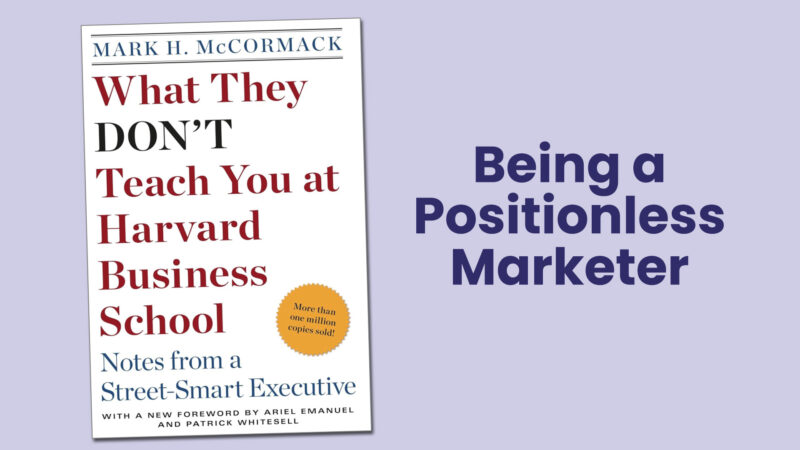What they don’t teach you about marketing at Harvard Business School: Being positionless
Positionless Marketing equates to do-it-now competence, powered by technology... not committees

What they didn’t teach you in the marketing org chart: how to win when the window is closing.
Picture a marketer who sees VIPs starting to lapse on a Thursday morning. By noon, they’ve pulled the data, developed three creative variants, launched a triggered journey and measured incremental improvement. No tickets, no queues, no committees.
By Monday, the save rate is up 18%. That’s not luck; that’s Positionless Marketing. It’s do-it-now competence, powered by technology.
The mindset comes straight from a classic business book: Mark McCormack’s “What They Don’t Teach You at Harvard Business School: Notes from a Street-smart Executive.” His playbook celebrates practical judgment, preparation, bias to action, relentless follow-through, relationships, and owning the details.
Mark H. McCormack (1930–2003) was the lawyer-turned-entrepreneur who essentially invented modern sports marketing. He founded IMG in 1960 after a handshake deal with Arnold Palmer (later adding Jack Nicklaus and Gary Player) and pioneered athlete representation, brand endorsements, event management, licensing and media rights, building IMG into a global powerhouse.
Positionless Marketing applies McCormack’s same street-smart principles to modern marketing by collapsing the assembly line so one marketer can prepare, act and close the loop without waiting on analysts, designers, or engineers. The result is speed with accountability.
Here are five bridges from McCormack’s playbook to Positionless practice.
1) Preparation beats pedigree: Data power
McCormack’s edge begins before the meeting: know the person, the room, the leverage. In Positionless Marketing, data power puts that prep at a marketer’s fingertips. Propensity scores, lifecycle stage, content affinity, margin constraints, channel history—surfaced instantly—let a single owner tailor the “pitch” (offer, timing, channel) before a touch ever goes out.
Old way: Wait a week for an audience pull.
Positionless way: Define and size the audience in minutes, with built in profit and frequency guardrails.
2) Bias to action: Creative power
McCormack wouldn’t over-theorize; he’d get a proposal out today. Creative power does that for campaigns. Generative tools produce channel-ready copy and visuals in minutes, so a marketer can ship the minimum viable message now, not after a studio queue.
Old way: Brief → sprint → reviews → missed moment.
Positionless way: three variants live this afternoon, with tone, brand and compliance templates baked in. Generative AI drafts the headlines, renders the hero images and adapts copy for email, SMS and push… while a human marketer steers strategy and approves the output.
3) Follow-through is everything: Optimization power
After the meeting, McCormack locked next steps. In Positionless, Optimization power is that follow-through: automated next-best actions, live tests and incrementality measurement that turn intent into outcomes.
Old way: “Let’s see how it did” in next month’s deck.
Positionless way: Experiments auto-allocate to winners, journeys self-tune, and show lift in real time.
4) Relationships over transactions: Personalization at scale
People buy from people who “get” them. Positionless marketers orchestrate lifecycles that feel human because they’re timely and relevant: day-one welcomes that actually onboard; milestone nudges that reward progress; win-backs that reference history rather than reset to zero.
Old way: the same 20%-off blast to everyone.
Positionless way: right offer, right moment, right channel… because the context is understood.
5) Own the details: Cut the assembly line
McCormack won on details. In Positionless Marketing, one owner controls the full chain: insight to creative to launch to measurement. Details don’t die in handoffs. No lost audiences, outdated extracts, mis-sized segments, or “we’ll fix it next sprint.” The same person who saw the opportunity can prove the outcome.
This isn’t anti-strategy; it’s anti-handoff. Strategy sets the playing field… who we serve, what we promise, how we win. Positionless changes the physics of execution within that field. When the same marketer can prepare, create, and optimize in a single afternoon, the organization gains cycle time and clarity.
Proof points from Positionless teams:
- Time-to-launch: From days to minutes. Campaigns that once took a week go live before lunch. Consider Caesars Entertainment that reduced campaign execution time from five days to five minutes
- Leading consumer brands have achieved 16.1x increase in purchase rates while saving 300 working hours per year, all with the same team size
- FDJ United condensed what used to require seven teams and six weeks into a single-person, single-day workflow
A practical playbook: McCormack in spirit
- Equip every marketer with the three powers. Data access without tickets, generative creative with brand guardrails and optimization that runs by default. If a task requires a queue, ask why.
- Replace the static calendar with a rolling experiment backlog. Keep always-on journeys tuned; reserve the calendar for moments that truly require orchestration. Measure teams on learning velocity and incremental revenue.
- Codify “street smarts” as system smarts. Document quick wins: early access for loyalists, charm-tier offers that beat deep discounts, time-of-day effects, and turn them into reusable policies the platform enforces.
McCormack’s lesson wasn’t “be reckless.” It was “be ready, act fast and follow through.” Positionless Marketing is that mindset operationalized. It takes the discipline of direct, data-driven marketing and removes the delay, giving one accountable owner the data power to prepare, the creative power to act and the optimization power to learn, again and again, until the results are undeniable.
The marketing org chart may still list roles. But today’s marketing belongs to the person who can see the opportunity, move now, and prove what happened. That’s how deals got done in McCormack’s world. And Positionless is how marketing closes the deal with customers in real-time today.
Opinions expressed in this article are those of the sponsor. MarTech neither confirms nor disputes any of the conclusions presented above.
Related stories
New on MarTech
